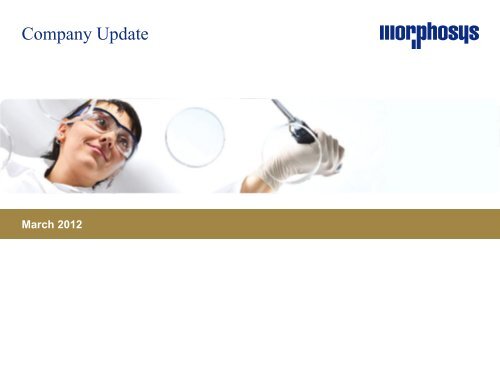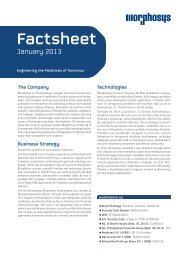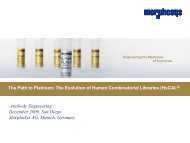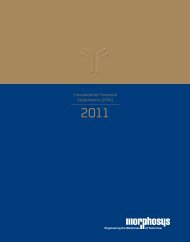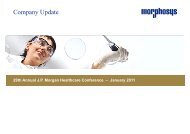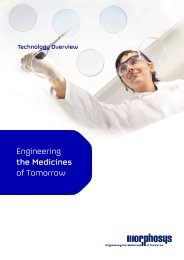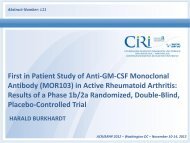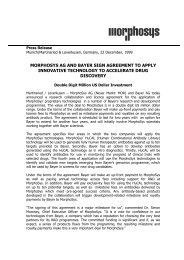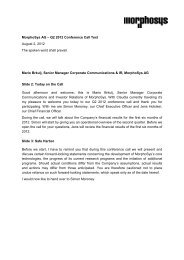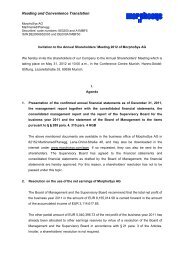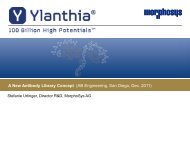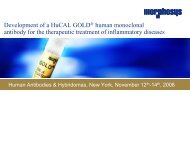Create successful ePaper yourself
Turn your PDF publications into a flip-book with our unique Google optimized e-Paper software.
<strong>Company</strong> <strong>Update</strong><br />
March 2012
Safe Harbour<br />
This presentation includes forward-looking statements.<br />
Actual results could differ materially from those included in the forward-looking statements<br />
due to various risk factors and uncertainties including changes in business, economic<br />
competitive conditions, regulatory reforms, foreign exchange rate fluctuations and the<br />
availability of financing.<br />
These and other risks and uncertainties are detailed in the <strong>Company</strong>’s Annual Report.
Business Strategy<br />
Proprietary products<br />
Lucrative upside<br />
Partnerships<br />
Strong current cash-flow plus substantial<br />
upside through milestones & royalties<br />
Technology Powerful proprietary<br />
technology platform drives<br />
partnered programs…<br />
and increasingly, proprietary<br />
product development<br />
© <strong>MorphoSys</strong> AG<br />
Page 3
Maturing Pipeline Illustrates Successful<br />
Execution of Strategy<br />
Programs<br />
25<br />
20<br />
15<br />
10<br />
5<br />
0<br />
8<br />
4<br />
4<br />
17<br />
11<br />
6<br />
20<br />
20<br />
12 11<br />
2009 2010 2011 as of today<br />
Total Phase 1 Phase 2<br />
8<br />
9<br />
� 20 clinical programs ongoing<br />
� 16 with seven different partners<br />
� 4 proprietary, un-partnered programs<br />
� Disease areas include cancer,<br />
inflammation, CNS, ophthalmology,<br />
musculoskeletal, and others<br />
© <strong>MorphoSys</strong> AG<br />
Page 4
Strong Track Record of Technological<br />
Innovation<br />
2001<br />
HuCAL<br />
30 commercial<br />
partnerships<br />
>€450 million<br />
revenues to date<br />
Most successful<br />
antibody library<br />
technology<br />
2010 2010<br />
Slonomics<br />
Generation of<br />
customized protein<br />
libraries<br />
4 deals since<br />
acquisition<br />
arYla Ylanthia<br />
Optimization of any<br />
therapeutic or<br />
diagnostic antibody<br />
2012<br />
Next-generation<br />
antibody library<br />
extends technology<br />
leadership<br />
© <strong>MorphoSys</strong> AG<br />
Page 5
Slonomics:<br />
Multiple Opportunities Beyond Antibodies<br />
6<br />
Slonomics<br />
Rx<br />
Proteins<br />
Research<br />
&<br />
Dx<br />
Industrial<br />
Enzymes<br />
� e.g. Pfizer deal<br />
(2010)<br />
� Second deal<br />
(2012)<br />
� e.g. Novozymes<br />
deal (2011)<br />
� e.g. Dana-Farber<br />
alliance (2011)<br />
© <strong>MorphoSys</strong> AG<br />
Page 6
76 Therapeutic Antibody Programs Ongoing,<br />
20 in Clinical Trials<br />
Program Partner Indication Discovery Pre-clinic Phase 1 Phase 2<br />
MOR103 (2 programs) -<br />
Rheumatoid arthritis,<br />
Multiple sclerosis<br />
CNTO888 (2 programs) Janssen Biotech/J&J Cancer,<br />
Idiopathic pulmonary fibrosis<br />
CNTO1959 Janssen Biotech/J&J Psoriasis<br />
BHQ880 Novartis Cancer<br />
BYM338 Novartis Musculoskeletal<br />
NOV – 3 Novartis not discl.<br />
NOV – 4 Novartis Ophthalmology<br />
Gantenerumab Roche Alzheimer’s Disease<br />
MOR208 - Cancer<br />
MOR202 - Cancer<br />
BAY94-9343 (ADC) Bayer HealthCare Cancer<br />
BI – 1 Boehringer Ingelheim not discl.<br />
CNTO3157 Janssen Biotech/J&J Asthma<br />
CNTO – 5 Janssen Biotech/J&J Inflammation<br />
NOV – 5 Novartis Inflammation<br />
OMP-18R5 Oncomed Cancer<br />
OMP-59R5 Oncomed Cancer<br />
PFE – 1 Pfizer Cancer<br />
24 Partnered Programs Various Partners Various Indications<br />
32 Programs, incl.<br />
2 co-dev with Novartis<br />
Various Partners Various Indications<br />
New<br />
New<br />
New<br />
New<br />
68 Partnered Programs<br />
8 Proprietary Programs<br />
New in 2011/2012<br />
© <strong>MorphoSys</strong> AG<br />
New<br />
New<br />
New<br />
Page 7
Current Pipeline<br />
Projected HuCAL Drugs on the Market<br />
Discovery Preclinic Phase 1 Phase 2 Phase 3 Market<br />
32<br />
50% 70% 40% 65%<br />
Projection from today’s pipeline:<br />
24<br />
Success probability of 11%<br />
Projected number of marketed HuCAL drugs from today’s pipeline: 14<br />
Source: <strong>MorphoSys</strong> internal statistics & Tufts Centre for the Study of Drug Development<br />
Success probability of 18%<br />
11 Success probability of 25%<br />
9 Success probability of 33% 3<br />
© <strong>MorphoSys</strong> AG<br />
4<br />
4<br />
3<br />
Page 8
MOR103<br />
New Mode of Action in Inflammation<br />
The Drug<br />
� Ultra-high affinity HuCAL IgG1 targeting GM-CSF<br />
Market<br />
� Large commercial potential in inflammatory<br />
conditions including RA, MS, & others<br />
� Revenues with approved biologics in RA in 2010<br />
exceeded USD15bn<br />
Intellectual Property<br />
� Exclusive license to a US patent covering anti-<br />
GM-CSF antibodies for the treatment of chronic<br />
inflammatory conditions<br />
� US patent on MOR103 composition of matter<br />
Development<br />
� European phase 1b/2a trial in RA fully recruited,<br />
data expected Q3 2012<br />
� Ph1b safety study in MS patients initiated in Q4/11<br />
� PK study for sc administration initiated in Q1/12<br />
Phase 2 data for mavrilimumab, vs. GM-CSF<br />
receptor, provides clinical validation of the<br />
pathway in rheumatoid arthritis<br />
Proportion of subjects achieving a change of 1.2 from<br />
baseline in DAS28-CRP<br />
Source: ACR2011 Abstract: Mavrilimumab (an Anti-GM-CSFRα<br />
Monoclonal Antibody) in Subjects with Rheumatoid Arthritis:<br />
Results of a Phase 2 Randomized, Double-Blind, Placebo-<br />
Controlled Study<br />
http://acr.confex.com/acr/2011/webprogram/Paper24567.html<br />
© <strong>MorphoSys</strong> AG<br />
Page 9
GM-CSF is a Key Target in the<br />
Pathophysiology of Inflammatory Diseases<br />
Adapted from:<br />
Hamilton JA, (2008) Nat Rev Immunol. 8:533-44<br />
© <strong>MorphoSys</strong> AG<br />
Page 10
MOR103<br />
European Phase 1b/2a Trial in RA<br />
Trial<br />
A Study of the safety and preliminary efficacy of MOR103, a human antibody to<br />
granulocyte macrophage colony-stimulating factor (GM-CSF)<br />
Patients Patients with active rheumatoid arthritis<br />
Study Design<br />
Randomized, double-blind, placebo-controlled, multi-center dose-escalation<br />
study (three groups with 0.3/1.0/1.5 mg/kg) of MOR103 on background of stable<br />
regimen of concomitant RA therapy (NSAIDs, steroids, non- biological<br />
DMARDs)<br />
Primary Endpoint Adverse event rate and safety profile<br />
Secondary Endpoints<br />
Study Details<br />
DAS28, ACR core set measures and EULAR28 response criteria, hematology,<br />
blood chemistry, Ig levels, cytokines, synovitis, bone edema<br />
� 96 patients<br />
� Sites in Germany, The Netherlands, Bulgaria, Poland, Ukraine<br />
� Inclusion of MRI to detect an effect on inflammatory changes such as<br />
synovitis or bone edema<br />
� Results in Q3 2012<br />
© <strong>MorphoSys</strong> AG<br />
Page 11
MOR103<br />
European Phase 1b Trial in MS<br />
Trial<br />
Patients<br />
Study Design<br />
Phase Ib study to evaluate the safety and pharmacokinetics of MOR103, a<br />
human antibody to GM-CSF, in patients with multiple sclerosis (MS)<br />
Patients with relapsing-remitting or secondary progressive MS (RRMS or<br />
SPMS)<br />
A randomized, double-blind, placebo-controlled study (three groups with<br />
0.5/1.0/2.0 mg/kg; 6 doses) to evaluate the safety and pharmacokinetics of<br />
MOR103, a human antibody to GM-CSF, in patients with multiple sclerosis<br />
Primary Endpoint Incidence and severity of adverse events<br />
Secondary Endpoints<br />
Study Details<br />
� Pharmacokinetic profile<br />
� Potential immunogenicity<br />
� 30 patients<br />
� Sites in Germany, Poland, UK<br />
� Results expected in 2013<br />
© <strong>MorphoSys</strong> AG<br />
Page 12
MOR208 (XmAb5574) – A Novel<br />
High-Potential Anti-Cancer Antibody<br />
The Drug<br />
� Humanized, high affinity anti-CD19 antibody,<br />
exclusive license from Xencor<br />
� Comprises a proprietary Xencor modification<br />
leading to rapid and sustained B-cell depletion<br />
Market<br />
� High unmet medical need in NHL, CLL & ALL<br />
Competitive Profile<br />
� Expect convenient dosing schedule<br />
� Straightforward manufacturing<br />
� Potential for good safety profile<br />
� Significantly increased ADCC compared to<br />
rituximab in vitro<br />
Development<br />
� Completion of phase 1 in CLL and reporting of<br />
interim data H2/12<br />
� Initiation of additional trials in B cell<br />
malignancies in 2012<br />
© <strong>MorphoSys</strong> AG<br />
Page 13
MOR208 (XmAb5574)<br />
Phase 1 Trial in the US<br />
Trial Safety and tolerability of MOR208 (XmAb5574) in Chronic Lymphocytic Leukemia<br />
Patients Patients with relapsed or refractory CLL/SLL<br />
Study Design<br />
� MOR208/XmAb5574 (humanized, Fc-engineered, anti-CD19 IgG1 antibody)<br />
� Open-label, multi-dose, single-arm, Phase 1, dose-escalation study<br />
Primary Endpoint To determine the dose limiting toxicities (time frame 28 days)<br />
Study Details<br />
� 30 patients<br />
� Identification of the maximum tolerated dose (MTD) and/or recommended<br />
dose(s) (RD) for further study<br />
� Characterization of safety and tolerability, PK, PD and immunogenicity<br />
� Evaluation of preliminary antitumor activity of XmAb5574 in patients with<br />
relapsed or refractory CLL/SLL<br />
� Study sponsored by Xencor, Inc.<br />
© <strong>MorphoSys</strong> AG<br />
Page 14
MOR202 – A Novel High-Potential Antibody<br />
for Multiple Myeloma<br />
The Drug<br />
� High affinity HuCAL antibody targeting CD38<br />
The Market<br />
� High unmet medical need in MM, accounting for<br />
approximately 1% of all cancers.<br />
� Median survival is approximately 3-5 years<br />
Competitive Profile<br />
� Use of targeted therapy in combination with standard<br />
regimens in myeloma can minimize adverse events<br />
while increasing efficacy<br />
� MOR202 monotherapy shows a dose-dependent<br />
reduction of multiple myeloma graft induced bone<br />
lysis (pre-clinical studies)<br />
� MOR202 plus bortezomib or lenalidomide<br />
synergistically inhibits bone lysis and substantially<br />
reduces M protein levels<br />
(pre-clinical studies)<br />
Development<br />
� Study to last until January 2015, interim reporting<br />
planned<br />
MOR202 / BOR<br />
MOR202 / LEN<br />
% lysis of vehicle control<br />
% lysis of vehicle control<br />
110<br />
100<br />
90<br />
80<br />
70<br />
60<br />
50<br />
40<br />
30<br />
20<br />
10<br />
0<br />
Non-inoculated<br />
110<br />
100<br />
90<br />
80<br />
70<br />
60<br />
50<br />
40<br />
30<br />
20<br />
10<br />
0<br />
Non-inoculated<br />
Bone lysis<br />
Vehicle<br />
MOR202 3mg/kg<br />
Vehicle<br />
0.6mg/kg BOR<br />
MOR202+BOR (3+0.6mg/kg)<br />
MOR202 3mg/kg<br />
LEN 50mg/kg<br />
MOR202+LEN (3+50mg/kg)<br />
normalised M protein level<br />
normalised M protein level<br />
1.4<br />
1.2<br />
1.0<br />
0.8<br />
0.6<br />
0.4<br />
0.2<br />
0.0<br />
1.6<br />
1.4<br />
1.2<br />
1.0<br />
0.8<br />
0.6<br />
0.4<br />
0.2<br />
0.0<br />
Vehicle<br />
MOR202 3mg/kg<br />
Vehicle<br />
© <strong>MorphoSys</strong> AG<br />
BOR 0.6mg/kg<br />
MOR202+BOR (3+0.6mg/kg)<br />
MOR202 3mg/kg<br />
M protein<br />
LEN 50mg/kg<br />
MOR202+LEN (3+50mg/kg)<br />
MOR202/BOR and MOR202/LEN combination<br />
therapy is superior to the respective mono therapies<br />
Page 15
MOR202<br />
European Phase 1/2a Trial<br />
Trial<br />
A phase I/IIa, open-label, multicentre, dose-escalation study to evaluate the safety<br />
and preliminary efficacy of the human anti-CD38 antibody MOR202 as monotherapy<br />
and in combination with standard therapy in subjects with relapsed/refractory multiple<br />
myeloma<br />
Patients Patients relapsed/refractory multiple myeloma; failure of at least 2 prior therapies<br />
Study Design<br />
Primary<br />
Endpoint<br />
Secondary<br />
Endpoints<br />
Study Details<br />
• MOR202 (anti-CD38 HuCAL IgG1 antibody)<br />
• Phase I dose escalation (iv administration of MOR202 for up to 2 cycles)<br />
• Phase IIa monotherapy extension (iv administration of MOR202 for up to 4 cycles)<br />
• Phase Ib MOR202 combined with bortezomib<br />
• Phase Ib MOR202 combined with lenalidomide<br />
• Determination of MTD and / or recommended dose (up to 20 weeks)<br />
• Safety & immunogenicity<br />
• Pharmacokinetics of MOR202<br />
• Overall response rate (standard response criteria, serum M protein levels)<br />
• Up to 82 patients<br />
• Study sites in Germany & Austria<br />
© <strong>MorphoSys</strong> AG<br />
Page 16
AbD Serotec Segment Complements<br />
Therapeutic Business<br />
Research Activities<br />
� Catalogue of 15,000+ products<br />
� Stable and recurring cash flows<br />
� Customers comprise universities,<br />
government bodies, life science<br />
companies<br />
� Website, eCommerce<br />
HuCAL – Diagnostic Applications<br />
� Custom antibody generation<br />
� Using proprietary technologies to<br />
deliver superior Dx antibodies<br />
� Future upside via royalties<br />
� Collaborations with more than 20<br />
diagnostics companies<br />
© <strong>MorphoSys</strong> AG<br />
Page 17
FY2011: Income Statement<br />
in € million 2011 2010 Change<br />
Revenues 100.8 87.0 +16%<br />
Cost of Goods Sold 7.0 7.3<br />
Total Research and Development Expenses 57.5 46.9<br />
Sales, General & Administrative Expenses 24.6 23.2<br />
Total Operating Expenses 89.1 77.4 +15%<br />
Other Operating Income 0.5 0.2<br />
Profit from Operations 12.2 9.8 +24%<br />
Finance Income 1.4 4.1<br />
Other Expenses 2.1 0.8<br />
Profit before Taxes 11.4 13.2 -14%<br />
Income Tax Expenses 3.2 4.0<br />
Net Profit 8.2 9.2 -11%<br />
EPS (diluted) 0.36 0.40<br />
© <strong>MorphoSys</strong> AG<br />
Page 18
Balance Sheet and Shareholder Structure<br />
EUR millions<br />
Assets<br />
Cash, Cash Equivalents &<br />
Marketable Securities<br />
Balance Sheet<br />
Dec. 31,<br />
2011<br />
Dec. 31,<br />
2010<br />
134.4 108.4<br />
Other Current Assets 20.3 24.1<br />
Total Non-Current Assets 73.7 77.3<br />
Total Assets 228.4 209.8<br />
Liabilities<br />
Total Current Liabilities 23.8 21.4<br />
Total Non-Current Liabilities 7.5 2.5<br />
Total Shareholders’ Equity 197.1 185.9<br />
Total Liabilities 228.4 209.8<br />
Shareholdings by Investor Type (12/2011)<br />
Treasury Stock<br />
0.7%<br />
Unidentified<br />
23%<br />
Novartis<br />
6.4%<br />
Retail Investors<br />
22%<br />
Management &<br />
Supervisory Boards<br />
1.9%<br />
Institutional<br />
Investors<br />
46%<br />
Shares issued: 23,112,167 (Dec. 31, 2011)<br />
© <strong>MorphoSys</strong> AG<br />
Page 19
Guidance 2012<br />
in € million 2012 2011<br />
Group Revenues 75 – 80 100.8<br />
Investment into Proprietary R&D 20 – 25 36.7<br />
Group EBIT 1 – 5 11.1<br />
in € million 2012 2011<br />
AbD Serotec Segment Revenues<br />
(at constant currency)<br />
AbD Serotec EBIT Margin<br />
(at constant currency)<br />
20 – 22 19.3<br />
~ 6% – 8% 5%<br />
© <strong>MorphoSys</strong> AG<br />
Page 20
Proprietary Clinical Programs to Advance<br />
Significantly in 2012<br />
RA<br />
MOR103<br />
Enrollment completed<br />
in phase 1b/2a trial in<br />
rheumatoid arthritis<br />
Data in Q3 2012<br />
SC<br />
MS<br />
MOR103<br />
Phase 1b trial in<br />
multiple sclerosis<br />
initiated in Q4 2011<br />
Data in 2013<br />
CLL<br />
MOR208<br />
Enrollment target<br />
nearly hit in phase 1<br />
trial<br />
Data in H2 2012<br />
MM<br />
MOR202<br />
Phase 1/2a trial<br />
initiated in Q3 2011<br />
Combination arms to<br />
start in 2013<br />
© <strong>MorphoSys</strong> AG<br />
Page 21
A Wealth of Clinical Data is Imminent<br />
NOV – 2 (Ophthalmology)<br />
CNTO – 1 (Inflammation)<br />
CNTO888 (Cancer)<br />
BYM338 (Musculoskeletal)<br />
CNTO3157 (Asthma)<br />
MOR208 (CLL)<br />
BHQ880 (Cancer)<br />
CNTO888 (IPF)<br />
OMP18-R5 (Cancer)<br />
OMP59-R5 (Cancer)<br />
MOR103 (RA)<br />
BYM338 (Musculoskeletal)<br />
NOV – 3 (n.d.)<br />
NOV – 3 (n.d.)<br />
NOV – 4 (Ophthalmology)<br />
PFE – 1 (Cancer)<br />
CNTO1959 (Psoriasis)<br />
BI – 1 (n.d.)<br />
BHQ880 (Cancer)<br />
NOV – 4 (Ophthalmology)<br />
NOV – 4 (Ophthalmology)<br />
NOV – 3 (n.d.)<br />
H2 2011 H1 2012 H2 2012 H1 2013<br />
light colors: phase 1<br />
dark colors: phase 2<br />
© <strong>MorphoSys</strong> AG<br />
PoC in 2012<br />
Page 22
Appendix
Novartis Alliance: Landmark Deal<br />
Timeline<br />
Novartis pays…<br />
� May 2004: Initial deal, including equity stake<br />
� November 2007: Major expansion<br />
� November 2017: End, subject to 2-year extension option<br />
� Approx. €20m p.a. technology license including HuCAL internalization fees<br />
� Approx. €20m p.a. in research funding<br />
� Over €250m milestones (probability adjusted)<br />
� Royalties on all resulting drugs<br />
Novartis gets… � Preferred access to HuCAL for use in over 100 discovery programs<br />
Co-development<br />
option<br />
� Shared costs & profits (20% – 50%) on selected co-developed programs<br />
Excluded � Most infectious disease targets<br />
© <strong>MorphoSys</strong> AG<br />
Page 24
Partnerships: Typical Terms per Program<br />
€9m - €12m<br />
Phase 1 milestone<br />
Exclusive license fee; R&D funding<br />
<strong>MorphoSys</strong> costs<br />
Royalties<br />
(mid single<br />
digits)<br />
Phase 3 milestone<br />
Discovery Preclinic Phase 1 Phase 2 Phase 3 Market<br />
© <strong>MorphoSys</strong> AG<br />
Biologics<br />
License<br />
Application<br />
+<br />
Approval<br />
milestones<br />
Page 25
Partnered Programs<br />
Phase 2 Clinical Development<br />
Program Partner Disease Target Status<br />
CNTO888<br />
CNTO888<br />
CNTO1959<br />
Janssen<br />
Biotech<br />
Janssen<br />
Biotech<br />
Janssen<br />
Biotech<br />
Oncology<br />
Idiopathic<br />
pulmonary<br />
fibrosis<br />
CCL2<br />
(MCP-1)<br />
CCL2<br />
(MCP-1)<br />
Two trials ongoing, one trial completed<br />
Novel approach to IPF<br />
Psoriasis IL23p19 Phase 2 trial started in December 2011<br />
n.d. Novartis n.d. n.d. Clinical proof of concept achieved<br />
n.d. Novartis Ophthalmology n.d. Phase 2 trial started in January 2012<br />
BHQ880 Novartis<br />
Osteolytic bone<br />
disease<br />
DKK-1<br />
Early data show stimulation of bone<br />
formation<br />
BYM338 Novartis Musculoskeletal n.d. Two phase 2 trials ongoing<br />
Gantenerumab Roche<br />
Alzheimer‘s<br />
disease<br />
Amyloid-b<br />
Only anti-Aβ antibody being developed<br />
in patients with prodromal AD<br />
© <strong>MorphoSys</strong> AG<br />
Page 26
Partnered Programs<br />
Phase 1 Clinical Development<br />
Program Partner Disease Phase 1 Start<br />
BAY94-9343 Bayer Oncology September 2011<br />
n.d. Boehringer Ingelheim n.d. December 2010<br />
CNTO3157 Janssen Biotech Asthma June 2010<br />
n.d. Janssen Biotech Inflammation / Autoimmune December 2010<br />
n.d. Novartis Inflammation December 2010<br />
OMP-18R5 Oncomed Oncology April 2011<br />
OMP-59R5 Oncomed Oncology December 2010<br />
n.d. Pfizer Oncology December 2010<br />
© <strong>MorphoSys</strong> AG<br />
Page 27
Carlumab (CNTO 888): CCL2 Specific<br />
Antibody in Oncology<br />
A Study of the Safety and Efficacy of CNTO 888 in<br />
Combination With Standard of Care Chemotherapy in<br />
Patients With Solid Tumors<br />
Status Phase 1 (completed)<br />
Study Design Non-randomized, open-label safety study<br />
Study Start Date May 2010<br />
Completion Date n.d.<br />
Enrollment 53<br />
Primary<br />
Outcome<br />
Measures<br />
Secondary<br />
Outcome<br />
Measures<br />
Treatment<br />
Period<br />
The primary objective of the study is to<br />
evaluate the safety of CNTO 888 when<br />
administered to patients with solid tumors in<br />
combination with 4 standard of care<br />
chemotherapy regimens (docetaxel;<br />
gemcitabine; Paclitaxel and carboplatin; or<br />
DOXIL®/ Caelyx® doxorubicin HCl liposome<br />
injection)<br />
� Pharmacokinetics [during study as specified in<br />
the protocol and at End of Study (1 year)]<br />
� Pharmacodynamics [during study as specified<br />
in the protocol and at End of Study (1 year)]<br />
Combination therapy will be continued until<br />
disease progression, unacceptable toxicity, the<br />
patient refuses further combination therapy,<br />
withdraws consent, or is treated for 1 year<br />
A Study of the Safety and Efficacy of Single-agent CNTO 888<br />
(an Anti CC-Chemokine Ligand 2 [CCL2]) in Patients With<br />
Metastatic Prostate Cancer<br />
Status Phase 2 (completed)<br />
Study Design Non-randomized, open-label safety/efficacy study<br />
Study Start Date September 2009<br />
Completion Date July 2011<br />
Enrollment 46<br />
Primary<br />
Outcome<br />
Measures<br />
Secondary<br />
Outcome<br />
Measures<br />
Treatment<br />
Period<br />
The primary objective of the study is to determine<br />
the composite response in patients with<br />
metastatic castrate-resistant prostate cancer<br />
(CRPC) who receive single-agent 15 mg/kg<br />
CNTO 888 every 2 weeks (Time Frame: 3-6<br />
months)<br />
� Objective response rate determined as complete<br />
response and partial response according to<br />
Response Evaluation Criteria in Solid Tumors<br />
(RECIST) guidelines<br />
� Progression Free Survival<br />
� Overall Survival<br />
15mg/kg intravenously every 2 weeks until<br />
disease progression<br />
© <strong>MorphoSys</strong> AG<br />
Page 28
Carlumab (CNTO 888): CCL2 Specific<br />
Antibody in Idiopathic Pulmonary Fibrosis<br />
A Study to Evaluate the Safety and Effectiveness of CNTO 888 Administered Intravenously (IV) in Subjects With Idiopathic<br />
Pulmonary Fibrosis (IPF)<br />
Status Phase 2 (active, not recruiting)<br />
Study Design Randomized, double-blinded safety/efficacy study<br />
Study Start Date December 2008<br />
Completion Date June 2012<br />
Enrollment 129<br />
Primary Outcome Measures<br />
Secondary Outcome Measures<br />
Treatment Period<br />
The primary objective is to determine the efficacy (as measured by pulmonary function) and safety of<br />
CNTO 888 in subjects with IPF.<br />
To assess the effect of CNTO888 on measures of disease progression, patient reported outcomes,<br />
functional capacity and health-related quality of life, and to assess the pharmacokinetics/ pharmacodynamics<br />
of CNTO888 in subjects with IPF.<br />
� Patients will receive study agent until Week 48 and will continue to be followed through Week 72 for<br />
assessment of safety and any other effects after discontinuation of therapy.<br />
� Patients will be in the study for about 74 weeks.<br />
� Group 1: placebo<br />
� Group 2: 1 g/kg CNTO888 every 4 weeks<br />
� Group 3: 5mg/kg CNTO888 every 4 weeks<br />
� Group 4: 15 mg/kg CNTO888 every 4 weeks<br />
© <strong>MorphoSys</strong> AG<br />
Page 29
CNTO1959: HuCAL Antibody for the<br />
Treatment of Patients with Psoriasis<br />
A Study to Evaluate CNTO 1959 in the Treatment of Patients<br />
With Moderate to Severe Plaque-type Psoriasis (X-PLORE)<br />
Status Phase 2 (recruiting)<br />
Study Design<br />
Study Start Date October 2011<br />
Completion Date February 2014<br />
Enrollment 280<br />
Primary<br />
Outcome<br />
Measures<br />
Secondary<br />
Outcome<br />
Measures<br />
Treatment<br />
Randomized, double-blind, placebo-controlled<br />
study<br />
Physician's Global Assessment (PGA) score of<br />
cleared or minimal (Time Frame: Week 16);<br />
Overall assessment of induration, scaling, and<br />
erythema<br />
� Psoriasis Area and Severity Index (PASI) 75%<br />
or greater improvement from baseline<br />
(Time Frame: Week 16)<br />
� The difference in the PGA score of cleared (0)<br />
or minimal (1) response rate between CNTO<br />
1959 treatment groups and adalimumab treatment<br />
group (Time Frame: Weeks 16 and 40)<br />
� The change from baseline in Dermatology Life<br />
Quality Index (DLQI) (Time Frame: Week 16)<br />
� 5 groups: CNTO 1959 (5 mg / 15 mg / 50 mg /<br />
100 mg / 200 mg<br />
� Drug: Adalimumab<br />
� Drug: Placebo to CNTO 1959 (100 mg)<br />
A Study of the Safety, Tolerability, Pharmacokinetics, and<br />
Pharmacodynamics of CNTO 1959 Following a Single SC<br />
Administration in Japanese Participants With Moderate to<br />
Severe Plaque Psoriasis<br />
Status Phase 1 (recruiting)<br />
Study Design<br />
Study Start Date August 2011<br />
Completion Date June 2013<br />
Enrollment 32<br />
Primary<br />
Outcome<br />
Measures<br />
Secondary<br />
Outcome<br />
Measures<br />
Treatment<br />
Randomized, double-blind, placebo-controlled<br />
study<br />
� The number and type of adverse events<br />
� Change in clinical laboratory values<br />
� Electrocardiogram<br />
� Changes or abnormalities in body systems<br />
� Axillary temperature<br />
� Pulse rate<br />
� Blood pressure (Time Frame: Up to 24 weeks)<br />
� Blood levels of CNTO 1959<br />
� Antibodies to CNTO 1959<br />
� Psoriasis Area and Severity Index (PASI)<br />
Physician's Global Assessment (PGA)<br />
� Drug: CNTO 1959 (10mg, 30mg, 100mg,<br />
300mg, subcutaneous use, ascending dosing<br />
for 24 weeks<br />
� Drug: Placebo<br />
© <strong>MorphoSys</strong> AG<br />
Page 30
BHQ880: DKK-1 Specific Antibody in<br />
Multiple Myeloma Associated Osteolysis<br />
A Study to Assess BHQ880 in Combination With Zoledronic Acid in Relapsed or Refractory Myeloma Patients<br />
Status Phase 1/2 (active, not recruiting)<br />
Study Design Randomized, double-blinded safety/efficacy study<br />
Study Start Date January 2009<br />
Completion Date April 2012<br />
Enrollment 267<br />
Primary Outcome Measures<br />
Secondary Outcome Measures<br />
Treatment Period<br />
Time to first SRE and change in bone markers for bone resorption and formation (Time Frame: 9<br />
months minimum treatment with BHQ880 or placebo in combination with zoledronic acid and<br />
standard anti-myeloma therapy<br />
� Characterize acute and chronic safety and tolerability of BHQ880<br />
� Characterize single-dose and repeated-dose pharmacokinetic profiles of BHQ880<br />
� Assess the potential immunogenicity of BHQ880<br />
� Characterize the binding kinetics of DKK1/BHQ880 complex (free&BHQ880 bound DKK1) in serum<br />
� Determine the pharmacodynamic effects of BHQ880 by measuring biochemical markers of bone<br />
formation, resorption, and metabolism in serum and urine<br />
� Using Various Repeated IV Doses of BHQ880 in Combination With Zoledronic Acid<br />
� Group 1: Various intravenous doses (low) of BHQ880 (up to 20 mg/kg) in combination with<br />
zoledronic acid on day 1 of a 28-day cycle.<br />
� Goup 2: Various intravenous doses (medium) of BHQ880 (up to 20 mg/kg) in combination with<br />
zoledronic acid on day 1 of a 28-day cycle.<br />
� Group 3: Various intravenous doses (high) of BHQ880 (up to 20 mg/kg) in combination with<br />
zoledronic acid on day 1 of a 28-day cycle.<br />
� Group 4: Placebo in combination with zoledronic acid on day 1 of a 28-day cycle<br />
© <strong>MorphoSys</strong> AG<br />
Page 31
BHQ880: DKK-1 Specific Antibody in<br />
Multiple Myeloma Associated Osteolysis<br />
Study of BHQ880 in Patients With High Risk Smoldering Multiple Myeloma<br />
Status Phase 2 (recruiting)<br />
Study Design Non-randomized, open-label study<br />
Study Start Date May 2011<br />
Completion Date March 2013<br />
Enrollment 40<br />
Primary Outcome Measures<br />
Secondary Outcome Measures<br />
Treatment Period<br />
Overall response rate (Complete Response + Partial Response + Minimal Response) of patients<br />
achieving an objective response (defined according to the IMWG uniform response criteria by the<br />
Frequency of response of serum or urine M-protein to BHQ880A (Time frame: at 6 months)<br />
� Safety and tolerability of BHQ880 in patients with smoldering multiple myeloma by assessing AEs,<br />
SAEs, clinical laboratory values (Time frame: From start of study until disease progression )<br />
� Characterize the PK profile of BHQ880 as a single agent administered monthly by assessing<br />
BHQ880 levels in plasma (Time frame: Throughout the study until disease progression)<br />
� Evaluate the effect of BHQ880 on bone metabolism by assessing serum and urine bone<br />
biomarkers (Time frame: Throughout the study until disease progression)<br />
� Evaluate the effect of BHQ880 on bone mineral density by DXA scan and QCT (Time frame: 6<br />
months and 12 months)<br />
� This study will assess the antimyeloma effects of BHQ880A in patients with smoldering multiple<br />
myeloma with high risk of progression to active multiple myeloma<br />
� BHQ880 will be administered every 28 days in previously untreated patients.<br />
� Single arm<br />
© <strong>MorphoSys</strong> AG<br />
Page 32
BHQ880: DKK-1 Specific Antibody in<br />
Multiple Myeloma Associated Osteolysis<br />
Study in Patients With Untreated Multiple Myeloma and Renal Insufficiency<br />
Status Phase 2 (recruiting)<br />
Study Design Randomized, double-blinded study<br />
Study Start Date May 2011<br />
Completion Date February 2016<br />
Enrollment 144<br />
Primary Outcome Measures<br />
Secondary Outcome Measures<br />
Treatment Period<br />
Effect of BHQ880 compared with placebo on time to first Skeletal Related Event (SRE) in patients<br />
with untreated multiple myeloma and renal insufficiency in combination with bortezomib and<br />
dexamethasone (Time Frame: 18-month median time to first SRE assumed for the placebo arm)<br />
� Safety and tolerability of BHQ880 in combination with bortezomib and dexamethasone<br />
� Characterize the PharmacoKinetics (PK) profiles of BHQ880 and bortezomib (Determine the<br />
pharmacokinetic parameters for BHQ880 and bortezomib.<br />
� Evaluate the effect of BHQ880 on bone metabolism<br />
1) Change in bone mineral density, measured by dual-emission X-ray absorptiometry (DXA),<br />
2) Change in bone strength, measured by quantitative computed tomography (qCT),<br />
� Determine the anti-myeloma effect of BHQ880 compared to placebo when used in combination with<br />
bortezomib and dexamethasone<br />
1) The overall response rate (partial response plus complete response);<br />
2) Progression-free survival following initiation of BHQ880<br />
The study will evaluate the effects of BHQ880 in patients with previously untreated multiple<br />
myeloma and renal insufficiency who are not considered candidates for bisphosphonate therapy.<br />
The primary objective of the study will be to evaluate the effect of BHQ880 in combination with<br />
bortezomib and dexamethasone, compared to placebo administered with the combination on the<br />
time to first Skeletal Related Event (SRE) on study.<br />
© <strong>MorphoSys</strong> AG<br />
Page 33
BYM338: HuCAL Antibody for the<br />
Unintentional Weight Loss in Cancer Patients<br />
Efficacy, Safety and Tolerability of BYM338 in Patients With<br />
Sporadic Inclusion Body Myositis<br />
Status Phase 2 (recruiting)<br />
Study Design<br />
Study Start Date August 2011<br />
Completion Date December 2011<br />
Enrollment 12<br />
Primary<br />
Outcome<br />
Measures<br />
Secondary<br />
Outcome<br />
Measures<br />
Randomized, double-blind, placebo-controlled<br />
study<br />
Assessment of the affect of BYM338 on thigh<br />
muscle volume by MRI (time frame: 8 weeks)<br />
Assessment of the effect of BYM338 on muscle<br />
function by 'Timed Get Up and Go' test<br />
(Time frame: 8 weeks)<br />
Patients Patients with sporadic Inclusion Body Myositis<br />
Clinical Study of BYM338 for the Treatment of Unintentional<br />
Weight Loss in Patients With Cancer of the Lung or the<br />
Pancreas<br />
Status Phase 2 (recruiting)<br />
Study Design<br />
Study Start Date August 2011<br />
Completion Date September 2012<br />
Enrollment 50<br />
Primary<br />
Outcome<br />
Measures<br />
Secondary<br />
Outcome<br />
Measures<br />
Patients<br />
Randomized, double-blind, placebo-controlled<br />
study<br />
Increase in thigh muscle volume as measured by<br />
MRI (Time Frame: 8 Weeks)<br />
� 6 minute walk test (Time frame: 8 weeks)<br />
� Efficacy in treating unintentional weight loss<br />
(Time frame: 8 weeks)<br />
� Obtain pharmacokinetic data in this population<br />
(Time frame: 8 weeks)<br />
� Efficacy in improving total lean body mass<br />
(LBM) and total bone mineral content<br />
(Time frame: 8 weeks)<br />
� Improving physical activity and function<br />
(Time frame: 8 weeks)<br />
Patients With Stage IV Non-small Cell Lung<br />
Cancer or Stage III/IV Adenocarcinoma of the<br />
Pancreas<br />
© <strong>MorphoSys</strong> AG<br />
Page 34
Gantenerumab: Amyloid-ß Specific Antibody<br />
in Alzheimer‘s Disease<br />
A Study of Gantenerumab (RG1450) in Patients With Prodromal Alzheimer's Disease<br />
Status Phase 2 (recruiting)<br />
Study Design Randomized, double-blinded safety/efficacy study<br />
Study Start Date November 2010<br />
Completion Date April 2015<br />
Enrollment 360<br />
Primary Outcome Measures<br />
Secondary Outcome Measures<br />
Treatment Period<br />
Clinical Data<br />
� To evaluate the effect on the change in the Clinical Dementia Rating scale Sum of Boxes (CDR-<br />
SOB), a global measure of cognition and functional ability<br />
� Sub-study: Change in brain amyloid over time assessed with Positron Emission Tomography<br />
� Effect on cognition assessed with Alzheimer Disease Assessment Scale-Cognition<br />
� Effect on functioning assessed with Functional Activities Questionnaire<br />
� Safety (nature and incidence of adverse events)<br />
� Pharmacokinetics: gantenerumab levels<br />
� Patients will be randomized to receive subcutaneous injections of either gantenerumab or placebo<br />
� Patients who consent to be part of the sub-study will undergo positron emission tomography (PET)<br />
scanning to assess brain amyloid<br />
� The anticipated time on study treatment is 104 weeks.<br />
� Group 1: 225 mg gantenerumab subcutaneous doses every 4 weeks for 104 weeks<br />
� Group 2: 105 mg gantenerumab subcutaneous doses every 4 weeks for 104 weeks<br />
� Group 3: Placebo<br />
� In October 2011, Roche published first amyloid imaging data from Gantenerumab<br />
� The data, published in the Archives of Neurology, demonstrated a dose-dependent reduction of<br />
beta amyloid in the brain of patients treated with the monoclonal antibody, while amyloid load<br />
increased in patients on placebo<br />
© <strong>MorphoSys</strong> AG<br />
Page 35
Management Team<br />
Dr. Simon E. Moroney, CEO<br />
� Co-founder, previously at ImmunoGen<br />
� German Cross of the Order of Merit (2002), Bavarian State Medal for Outstanding<br />
Services to the Bavarian Economy (2009)<br />
Jens Holstein, CFO<br />
� Joined <strong>MorphoSys</strong> in 2011<br />
� Formerly at Fresenius: Regional CFO for region EME of Fresenius Kabi AG; several<br />
financial and general management positions at Fresenius; and in consulting industry<br />
Dr. Arndt Schottelius, CDO<br />
� Joined <strong>MorphoSys</strong> in 2008<br />
� Formerly Medical Director in Immunology at Genentech Inc.; Berlex Biosciences, USA;<br />
Schering, Germany; Charité University Hospital, Berlin<br />
Dr. Marlies Sproll, CSO<br />
� Joined <strong>MorphoSys</strong> in 2000, promoted to CSO in 2005<br />
� Formerly at Boehringer Ingelheim in Vienna; Merck KGaA in Darmstadt<br />
© <strong>MorphoSys</strong> AG<br />
Page 36
Covering Analysts<br />
Institution Contact<br />
Close Brother Seydler Mr. Igor Kim<br />
Commerzbank Mr. Daniel Wendorff<br />
Deutsche Bank Mr. Gunnar Romer<br />
DZ Bank Dr. Elmar Kraus<br />
Edison Dr. Mick Cooper<br />
Equinet Institutional Services Edouard Aubéry<br />
Helvea Dr. Olav Zilian<br />
Kempen & Co. Mr. Sachin Soni / Mr. Mark Pospisilik<br />
Landesbank Baden-Württemberg Mr. Timo Kürschner<br />
Nomura Code Dr. Gary Waanders<br />
WestLB AG Dr. Cornelia Thomas / Mr. Oliver Kaemmerer<br />
© <strong>MorphoSys</strong> AG<br />
Page 37
Upcoming Events & Conferences<br />
� March 22, 2012 Kempen Healthcare/Life Sciences Conference<br />
Amsterdam, The Netherlands<br />
� May 4, 2012 Q1 2012 Results<br />
� May 7-9, 2012 Deutsche Bank Health Care Conference<br />
Boston, USA<br />
� May 14-16, 2012 German Swiss & Austrian Conference 2012<br />
Frankfurt, Germany<br />
� May 15-16, 2012 BioEquity, Frankfurt, Germany<br />
� June 4-7, 2012 Jefferies 2012 Global Healthcare Conference<br />
New York, USA<br />
For more information please visit www.morphosys.com<br />
© <strong>MorphoSys</strong> AG<br />
Page 38
© <strong>MorphoSys</strong> AG Page
Thank You<br />
www.morphosys.com<br />
Dr. Simon Moroney<br />
Chief Executive Officer<br />
Phone +49 (0)89 / 899 27-311<br />
Fax +49 (0)89 / 899 27-5311<br />
HuCAL ® , HuCAL GOLD ® , HuCAL PLATINUM ® , Ylanthia ® , arYla ® , CysDisplay ® , RapMAT ® and AutoCAL ® are registered trademarks of <strong>MorphoSys</strong> AG.<br />
Slonomics ® is a registered trademark of Sloning BioTechnology GmbH, a subsidiary of <strong>MorphoSys</strong> AG.<br />
Dr. Claudia Gutjahr-Löser<br />
Head of Corporate Communications & IR<br />
Phone +49 (0)89 / 899 27-122<br />
Fax +49 (0)89 / 899 27-5122<br />
Email investors@morphosys.com


